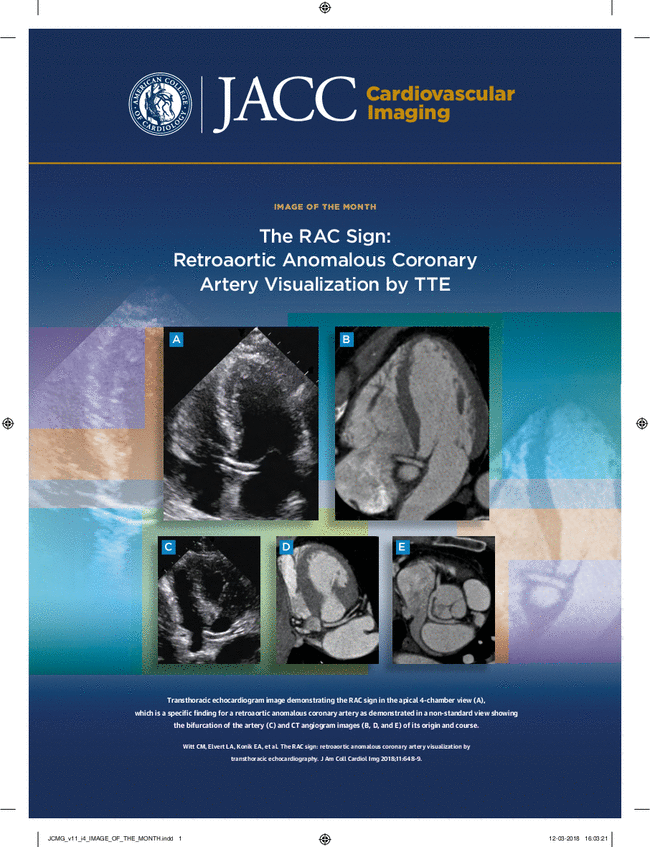Prognostic Time Frame of Plaque and Hemodynamic Characteristics and Integrative Risk Prediction for Acute Coronary Syndrome
IF 12.8
1区 医学
Q1 CARDIAC & CARDIOVASCULAR SYSTEMS
引用次数: 0
Abstract
Background
The relevant time frame for predicting future acute coronary syndrome (ACS) based on coronary lesion characteristics remains uncertain.
Objectives
The aim of this study was to investigate the association of lesion characteristics with test-to-event time and their prognostic impact on ACS.
Methods
The EMERALD II (Exploring the Mechanism of Plaque Rupture in Acute Coronary Syndrome Using Coronary CT Angiography and Computational Fluid Dynamics II) study analyzed 351 patients who underwent coronary computed tomography angiography (CTA) and experienced ACS between 1 month and 3 years of follow-up. Lesions identified on coronary CTA were classified as culprit (n = 363) or nonculprit (n = 2,088) on the basis of invasive coronary angiography findings at the time of ACS. Core laboratory coronary CTA analyses assessed 4 domains: degree of stenosis, plaque burden, number of adverse plaque characteristics (APC) (low-attenuation plaque, positive remodeling, spotty calcification, and napkin-ring sign), and changes in coronary CTA–derived fractional flow reserve across the lesion (ΔFFRCT). Patients were categorized into short (<1 year), mid (1-2 years), and long (2-3 years) test-to-event time groups.
Results
Patient characteristics, including cardiovascular risk factors, did not differ across short, mid, and long test-to-event groups (P > 0.05 for all), and the proportion of ACS culprit lesions was similar (P = 0.552). Among culprit lesions, shorter test-to-event time was associated with higher luminal stenosis, plaque burden, and ΔFFRCT (P for trend < 0.001 for all). The predictability for ACS culprit lesions based on the combined 4 characteristics tended to decrease over time and significantly reduced beyond 2 years (AUC: 0.851 vs 0.741; P = 0.006). In predicting ACS risk within test-to-event time <2 years using obstructive lesions (stenosis ≥ 50%), APC ≥2, plaque burden ≥70%, and ΔFFRCT ≥0.10, the risk was elevated compared to the average proportion of lesions becoming ACS culprit (12.1%) in the following subsets: lesions with 4 characteristics (proportion of lesions becoming ACS culprit: 49.3%; P < 0.001), lesions with 3 characteristics (obstructive lesions with plaque burden ≥70% and either ΔFFRCT ≥0.10 [proportion of lesions becoming ACS culprit: 33.0%; P < 0.001] or APC ≥2 [proportion of lesions becoming ACS culprit: 31.2%; P < 0.001]), and lesions with 2 characteristics (plaque burden ≥70% and ΔFFRCT ≥0.10; proportion of lesions becoming ACS culprit: 21.5%; P = 0.016).
Conclusions
Increased luminal stenosis, plaque burden, and ΔFFRCT were associated with shorter test-to-ACS event time. The prognostic impact of lumen, plaque, and local hemodynamic characteristics was most relevant to ACS risk within a 2-year period, with higher risk observed when specific combinations of them were present. (Exploring the Mechanism of Plaque Rupture in Acute Coronary Syndrome Using Coronary CT Angiography and Computational Fluid Dynamics II [EMERALD II] Study; NCT03591328)
斑块和血流动力学特征的预后时间框架及急性冠脉综合征的综合风险预测。
基于冠状动脉病变特征预测未来急性冠脉综合征(ACS)的相关时间框架仍不确定。目的本研究的目的是探讨病变特征与检测到事件时间的关系及其对ACS的预后影响。方法EMERALD II(利用冠状动脉CT血管造影和计算流体动力学探索急性冠状动脉综合征斑块破裂机制II)研究分析了351例接受冠状动脉CT血管造影(CTA)并经历ACS的患者,随访1个月至3年。根据ACS发生时冠状动脉造影的有创表现,将冠脉CTA上发现的病变分为罪魁祸首(n = 363)和非罪魁祸首(n = 2088)。核心实验室冠状动脉CTA分析评估了4个领域:狭窄程度、斑块负担、不良斑块特征(APC)数量(低衰减斑块、正重构、点状钙化和餐巾环征象),以及冠状动脉CTA衍生的病变分流血流储备的变化(ΔFFRCT)。患者分为短型(均为0.05),ACS罪魁祸首病变比例相似(P = 0.552)。在罪魁祸首病变中,较短的检测至事件时间与较高的管腔狭窄、斑块负担和ΔFFRCT相关(P表示趋势< 0.001)。基于4个特征的ACS罪魁祸首病变的可预测性随着时间的推移而降低,2年后显著降低(AUC: 0.851 vs 0.741;P = 0.006)。在预测试验-事件时间<2年的ACS风险时,使用梗阻性病变(狭窄≥50%)、APC≥2、斑块负担≥70%和ΔFFRCT≥0.10,与以下亚群中病变成为ACS罪魁祸首的平均比例(12.1%)相比,风险升高:具有4个特征的病变(病变成为ACS罪魁祸首的比例:49.3%;P < 0.001),病变具有3个特征(斑块负担≥70%或ΔFFRCT≥0.10),病变成为ACS罪魁祸首的比例为33.0%;P < 0.001]或APC≥2[病变成为ACS罪魁祸首的比例:31.2%;P < 0.001]),病变具有2个特征(斑块负荷≥70%,ΔFFRCT≥0.10;病变成为ACS罪魁祸首的比例:21.5%;P = 0.016)。结论:管腔狭窄、斑块负担和ΔFFRCT的增加与试验到acs事件的时间缩短有关。管腔、斑块和局部血流动力学特征的预后影响与2年内ACS风险最相关,当它们的特定组合存在时观察到更高的风险。应用冠状动脉CT血管造影和计算流体动力学探讨急性冠脉综合征斑块破裂机制[EMERALD II]研究;NCT03591328)。
本文章由计算机程序翻译,如有差异,请以英文原文为准。
求助全文
约1分钟内获得全文
求助全文
来源期刊

JACC. Cardiovascular imaging
CARDIAC & CARDIOVASCULAR SYSTEMS-RADIOLOGY, NUCLEAR MEDICINE & MEDICAL IMAGING
CiteScore
24.90
自引率
5.70%
发文量
330
审稿时长
4-8 weeks
期刊介绍:
JACC: Cardiovascular Imaging, part of the prestigious Journal of the American College of Cardiology (JACC) family, offers readers a comprehensive perspective on all aspects of cardiovascular imaging. This specialist journal covers original clinical research on both non-invasive and invasive imaging techniques, including echocardiography, CT, CMR, nuclear, optical imaging, and cine-angiography.
JACC. Cardiovascular imaging highlights advances in basic science and molecular imaging that are expected to significantly impact clinical practice in the next decade. This influence encompasses improvements in diagnostic performance, enhanced understanding of the pathogenetic basis of diseases, and advancements in therapy.
In addition to cutting-edge research,the content of JACC: Cardiovascular Imaging emphasizes practical aspects for the practicing cardiologist, including advocacy and practice management.The journal also features state-of-the-art reviews, ensuring a well-rounded and insightful resource for professionals in the field of cardiovascular imaging.
 求助内容:
求助内容: 应助结果提醒方式:
应助结果提醒方式:


